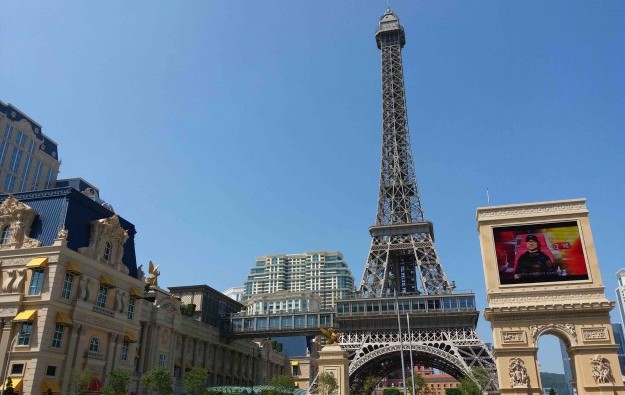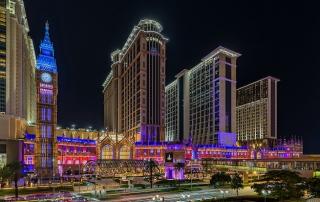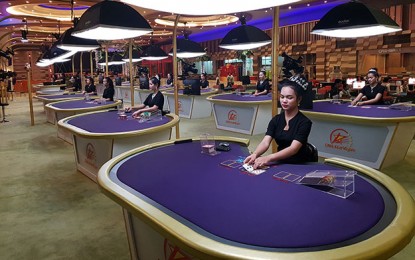LVS profit up 6pct in 4Q, Macau disappoints analysts
Jan 26, 2017 Newsdesk Latest News, Macau, Singapore, Top of the deck

U.S.-based casino operator Las Vegas Sands Corp reported an increase in company wide fourth quarter revenue, partially helped by the first full quarter of operation of its latest resort, the Parisian Macao (pictured), opened on September 13 in Macau’s Cotai district.
Group-wide, on a U.S. generally accepted accounting principles (GAAP) basis, Las Vegas Sands’ net revenue in the three months to December 31 increased by 7.4 percent year-on-year to US$3.08 billion, the company said on Wednesday.
Net income increased by 5.6 percent to US$607 million in the fourth quarter of 2016, compared to US$575 million in the year-ago quarter, the firm said.
The performance of the company’s Macau operations during the period disappointed several analysts, although management downplayed those concerns during a follow-up conference call to discuss the fourth quarter numbers.
“In Macau, our industry-leading Cotai Strip property portfolio, which has been meaningfully expanded by the opening of the Parisian Macao, generated growth of 16 percent in the mass gaming segment,” Las Vegas Sands chairman and chief executive Sheldon Adelson said in a statement included in the company’s results announcement.
“Las Vegas Sands reported Macau EBITDA [earnings before interest, taxation, depreciation and amortisation] 5 percent below the Street [investment community], and normalised results 11 percent below,” analysts Cameron McKnight and Robert Shore, from Wells Fargo Securities LLC, wrote in a note following the company’s results announcement.
They added: “We think it was a disappointing quarter, given Macau market revenues were up 10 percent quarter-on-quarter in the fourth quarter… In our view, the miss was driven by lower than expected market share, higher promotions and discounts, and higher than expected operational expenses.”
According to analysts Vitaly Umansky, Zhen Gong and Yang Xie from Sanford C. Bernstein Ltd, “the Parisian ramp up is progressing, but the results were weaker than we had expected.” They added: “These were generally offset by lower than anticipated cannibalisation at legacy properties.”
In the opinion of Grant Govertsen from Union Gaming Securities Asia Ltd, “the miss [in Macau] was primarily a function of exuberance in the context of a market recovery, and revenue mix with lower-margin premium mass growth notably outpacing base mass.” He added: Sands China Ltd – the Macau-based subsidiary of Las Vegas Sands – “is a behemoth and earnings growth is unlikely to be explosive in the absence of a V-shaped market recovery.”
On a GAAP basis, total net revenues for Sands China increased by 12.0 percent to US$1.86 billion in the fourth quarter of 2016. Net income for Sands China decreased by 7.9 percent to US$348 million in the period, according to the parent company.
Full year 2016 total net revenues for Sands China declined 2.5 percent to US$6.69 billion, compared to US$6.86 billion in 2015. Net income fell by 15.9 percent year-on-year to US$1.22 billion in 2016.
Social media helped Parisian
The fourth quarter results of Sands China included Parisian Macao’s first full quarter of operation. Revenue and adjusted property EBITDA at the property were US$344 million and US$95 million, respectively, resulting in an adjusted property EBITDA margin of 27.6 percent, according to Las Vegas Sands.
Speaking on the conference call with analysts following the fourth quarter results announcement, Mr Adelson said the Parisian “greatly enhanced the critical mass benefits of our interconnected properties on the Cotai Strip, as evidenced by our visitations going [up] 23 percent year-over-year in the fourth quarter”.
Mr Adelson attributed part of the Parisian Macao results to an ongoing social media promotional campaign, which reportedly achieved already more than 2 billion impressions. “This awareness has translated into strong property visitation,” he said. According to in-house research performed by Sands China, the Parisian Macao is already the second most popular casino resort in Macau, only behind sister property Venetian Macao, noted Mr Adelson.
Non-rolling chip drop at the Parisian Macao was US$895 million, with a win percentage of 18.3 percent. Rolling chip volume was US$3.31 billion, with a win percentage of 4.52 percent. Slot handle for the three months ended December 31 was US$803 million and hotel occupancy was 91.1 percent with an average daily rate of US$138.
“We are somewhat surprised at the strength of the premium mass demand for Parisian,” said Robert Goldstein, president and chief operating officer of Las Vegas Sands during the conference call.
He added: “We positioned it more as a mass property. We are rethinking the room mix, we are adding some more suite product. It won’t kick until late in 2017.”
Other properties in Sands China’s portfolio – namely Venetian Macao, Sands Cotai Central and and Sands Macao – reported declines in net revenue, mainly due to decreases in casino revenue. The Four Seasons Hotel Macao and Plaza Casino was the only property to buck the trend, posting a 3.2 percent increase in net revenue in the fourth quarter to US$163 million.
The Las Vegas Sands management also announced plans to built a second air-conditioned pedestrian bridge connecting Sands Cotai Central to its sister properties across the road in Cotai. The request was currently being reviewed by the Macau government and Las Vegas Sands expected construction to be completed still in 2017.
MBS mall sale moving ahead
In Singapore, where Las Vegas Sands developed and operates the Marina Bay Sands, adjusted property EBITDA was US$366 million in the fourth quarter on net revenue of US$723 million. That compared with adjusted property EBITDA of US$339 million and net revenue of US$703 million a year earlier.
“Marina Bay Sands continues to deliver steady cash flow, supported by its mass gaming and non-gaming sectors,” Mr Adelson commented.
The Singapore property reported rolling chip win percentage of 2.87 percent in the fourth quarter of 2016, above the 2.39 percent achieved in the fourth quarter of 2015, but “within the expected range”, parent Las Vegas Sands said. Rolling chip volume was US$8.26 billion for the quarter.
Mr Adelson also confirmed that Las Vegas Sands was preparing to sell a 49-percent stake in the shopping mall at Marina Bay Sands. “We are in preparation with our bankers to prepare that property to sell,” he said. “We expect to receive a very hefty, very significant price for the 49 percent we are going to sell,” he added, noting that the firm was not allowed to go ahead with the sale until March.
According to Las Vegas Sands management, the firm expects to get between US$3 billion and US$3.5 bilion from the sale.
Speaking on the conference call with analysts, Mr Adelson reaffirmed the company’s interest in investing in Japan.
“We’re excited by the recent legislature breakthrough in Japan to permit casino gaming within integrated resorts,” he said. “We believe our pioneering track record of creating the MICE-based integrated resort, our development experience and our financial strength put us in the pole position to take advantage of an opportunity in Japan and other new development opportunities in the horizon.”
Mr Adelson said he would be visiting Japan in February to give a talk at an event. He added he expected Japanese integrated resorts to be modelled after Marina Bay Sands, which could benefit Las Vegas Sands.
Legislation making casino gambling legal in Japan came officially into effect on December 26. That piece of legislation – referred to by its supporters prior to its enactment, as the Integrated Resorts Promotion Bill – got the final approval from Japan’s parliament on December 14.
Casino legalisation in Japan is a two-statute process. After approval of the enabling bill legalising casino resorts at the conceptual level, a second piece of legislation has now to be passed, detailing the specifics, including how casinos are administered and regulated.
In Las Vegas Sands’ home market of Las Vegas, adjusted property EBITDA increased by 14.4 percent year-on-year to US$111 million in the fourth quarter of 2016. Revenue for that market went up by 3.0 percent from the prior-year period, to US$412 million.
For full-year 2016, Las Vegas Sands reported net revenue of US$11.41 billion, down 2.4 percent from the previous year. Net income stood at US$1.67 billion, a decline of 15.1 percent from 2015.
Related articles
-
 Broker cuts Macau 2H mass GGR by 3pct...
Broker cuts Macau 2H mass GGR by 3pct...Jul 26, 2024
-
 MBS Tower 3 rooms revamp now by 2Q...
MBS Tower 3 rooms revamp now by 2Q...Jul 25, 2024
More news
-
 Donaco EBITDA up y-o-y to above US$4mln...
Donaco EBITDA up y-o-y to above US$4mln...Jul 26, 2024
-
 HK listed Palasino upgrades Czech...
HK listed Palasino upgrades Czech...Jul 26, 2024
Latest News
Jul 26, 2024
Border-casino operator Donaco International Ltd has achieved a 164.17-percent year-on-year increase in its latest quarterly group earnings before interest, taxation, depreciation and amortisation...Sign up to our FREE Newsletter
 (Click here for more)
(Click here for more)
Pick of the Day
”We’ve got more traction outside of Macau at the moment. But Macau’s going be a bigger focus for us”
David Punter
Regional representative at Konami Australia
Most Popular
 Sheraton brand to exit Londoner Macao, to be Londoner Grand July 25, 2024
Sheraton brand to exit Londoner Macao, to be Londoner Grand July 25, 2024  Macau regulator probes unlicensed gaming agents July 24, 2024
Macau regulator probes unlicensed gaming agents July 24, 2024  Philippines gives 20k aliens in POGOs 60 days to leave July 25, 2024
Philippines gives 20k aliens in POGOs 60 days to leave July 25, 2024  Philippines-listed DigiPlus says not affected by POGO ban July 24, 2024
Philippines-listed DigiPlus says not affected by POGO ban July 24, 2024  Sands China 2Q EBITDA down q-o-q amid low hold, renovation July 25, 2024
Sands China 2Q EBITDA down q-o-q amid low hold, renovation July 25, 2024






